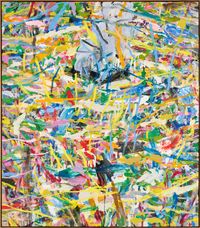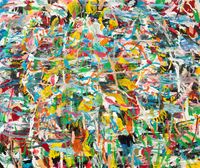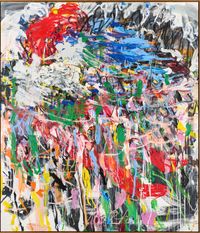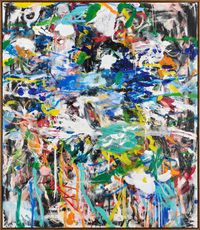Zimbabwean artist Misheck Masamvu creates paintings, sculptures, and drawings that flow between an individual and communal voice to tell stories deeply rooted in the context of contemporary Zimbabwe. In a political practice characterised by bold, loose brushstrokes and vivid colours, the artist leans into discomfort as a tool with which to provoke the viewer.
Read MoreOriginally a realist painter, Masamvu slowly gravitated towards an approach to figuration more reminiscent of Abstract Expressionism. In one interview, he describes oil painting as 'playing in the mud mixed with tears and your sweat.' This emotive, energetic approach to painting is palpable in his vibrant canvases and yet simultaneously belies a sense of conflict and ambivalence. In layer upon layer of paint, the artist uses the confident gestural strokes of Abstract Expressionism alongside figurative elements to create a nuanced portrait of contemporary Zimbabwean life; a portrait that is both a critical analysis of the nation's flaws and a passionate love letter to his home and community.
Masamvu's practice is preoccupied with the socio-political environment of post-independence Zimbabwe. Zombie President (2017)— one of a series of president-themed paintings— satirically portrays the eroding effects of greed and despotism. Using art as a form of activism, the artist looks to comment on the current political landscape, and in doing so, empower his fellow Zimbabweans towards a better future.
To best reflect this uncomfortable political climate, Masamvu's paintings invite the viewer into feelings of discomfort. In one interview, the artist compares a painting to a sunset, remarking that a sunset is more beautiful with clouds. In Thigh Lock (2013), the possibility of sex and violence merge to create a layered narrative in which it is not known if the outcome is pleasure or pain. In Gift from John the Baptist (2017), the famous image of John the Baptist's head on a platter is complicated by a body still attached underneath the platter. In Knuckle Bones (2018), the artist uses colours in a range of pastel shades to evoke the youthful atmosphere of the childhood game, and yet there is also a sense that something sinister lurks beneath. By creating an unstable narrative that often verges on the grotesque, the artist captures the viewer's attention with a more sustained gaze.
Though best known for his paintings, the distinctive tone of Masamvu's sculptures adds another layer of complexity to his practice. While his canvases are dynamic worlds of colour, the sculptures are more subdued and minimalist. The stained wood carving Misheck we miss you love from dead mother and twin sister (2017) is shaped like a flat, elongated 'H', and is painted black except for three white cuffs. When installed it leans against the wall, standing around human height. Though the piece itself does not reveal as much as some of the artist's paintings, the title hints at a much deeper story, lending the sculpture a similar narrative energy to the paintings.
Masamvu studied at Atelier Delta and Munich's Kunstakademie. He represented Zimbabwe in the 54th Venice Biennale in 2011, and has participated in a range of other prestigious exhibitions and events both locally and internationally.
Casey Carsel | Ocula | 2019







